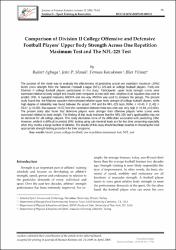Comparison of Division II College Offensive and Defensive Football Players' Upper Body Strength Across One Repetition Maximum Test and The NFL-225 Test
Özet
The purpose of this study was to evaluate the effectiveness of predicting actual one repetition maximum (1RM) bench press strength from the National Football League (NFL) 225-test in college football players. Forty-one Division 11 college football players participated in this study. Participants' zipper body strength scores were expressed relative to body weight and results were compared across both tests. Mayhew et al. equation was used to predict 1RM. A repeated measures ANOVA and one-way ANOVA was used to compare the groups. The present study found that the Mayhew equation overestimated relative zipper body strength of college football players, while high degree of reliability was found between the actual 1RM and the NFL-225 tests [Wilks lambda = .43, F (1,40) = 53.07, p = .000, Eta-squared = .57] and the correlation between these two tests was very high (r = .94, p<.001). The present study also found that defensive players were stronger than offensive players it,hen scores were expressed relative to body weight. The finding of this study indicates that the NFL-225 test's applicability may not be identical for all college players. This study elucidates some of the difficulties associated with predicting 1RM. However, while it is difficult to predict 1RM, testing using sub-maximal loads are far less time consuming especially when they involve a large number of athletes. The results of this study should facilitate coaches in choosing the most appropriate strength testing procedure for their programs.


















